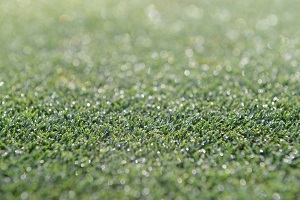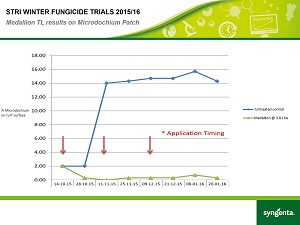AUTUMN DEW POINTS TO DISEASE RISK
Dewy mornings highly conducive to Microdochium patch
As we move into autumn, moist air flows from the west create dewy mornings with wet leaf surfaces that are slow to dry. Combined with the milder conditions seen in recent years, it is likely to lead to early outbreaks of foliar diseases.

With slowing grass growth and the high-risk conditions, problems with Microdochium Patch (Fusarium) outbreaks set to increase, highlighted Syngenta’s Daniel Lightfoot. “As the nights get colder and soil temperatures cool, slower growth means any damage affecting playing surface quality occurring now could last right through to the spring.
“Initial reports this season indicate that the Microdochium nivale pathogen is active, with outbreaks triggered by the onset of misty autumnal mornings an early warning of the potential risk this winter.”
Daniel advocated that during extended autumn growing conditions, Banner Maxx or Instrata will provide the most effective protection for active plants - with Instrata the optimum choice if infection is clearly visible.
“As growing conditions slow, however, the contact+ Medallion TL will be more appropriate to reduce the pathogen presence already in the thatch and protect the leaf for prolonged periods,” he added.
Results of new trials at STRI in Yorkshire has highlighted the value of proactive early Medallion TL treatments to reduce disease inoculum prior to periods of risk, to give long-lasting protection through weather conducive to disease.
Daniel reported that, first applied in mid-October, just a few days ahead of infection causing visible damage to the turf (spots covering >2% of the surface), Medallion TL treated plots had zero infection a month later. Over the same period, infection on untreated plots had escalated to 14% of the surface area – which would have been having serious effects on playability and players’ comments of turf quality.

Using a proactive full three-spray trial programme, at 28 day intervals, Medallion TL plots still had zero infection at the end of January - over 50 days since the final application. Untreated plots had reached 16% surface infection over the course of the winter.
“With the turf protected, any initial infection cleared up, and then stayed clean right through the winter,” commented Daniel. “It further reinforced the advice to use fungicides preventatively at the very first signs of disease, and to maintain protection through risk periods over the winter.”
He pointed out that turf mangers and agronomists can get advance warning of impending disease risks on the free Greencast website, along with weather and spraying conditions that may affect the ability to react.
“Greencast also holds a historic record of localised disease risks through the season for all areas of the UK,” he said. “That can be extremely valuable for identifying trends, and give the opportunity for more appropriate product selection and treatment timing to get the best possible results.”

Historic disease charts for last year showed that Microdochium Patch (Fusarium) risks really kicked-off during October, with several peaks through the month. Knowledge of weather triggering key risk periods helps with appropriate proactive preventative fungicide application timing.
|